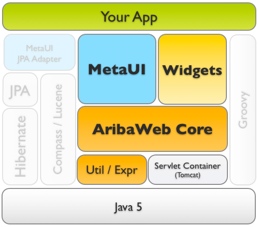 In this section we'll introduce the MetaUI framework.
MetaUI builds upon AribaWeb Core (and, tangentially, on Widgets) to assemble interfaces
on the fly (without templates). We'll cover the following:
In this section we'll introduce the MetaUI framework.
MetaUI builds upon AribaWeb Core (and, tangentially, on Widgets) to assemble interfaces
on the fly (without templates). We'll cover the following:
Let's add another field on the Post object:
public class Post {
...
public int rating = 3;
public boolean isPrivate;
}
To display this new field in the UI, we can add an entry to the FormTable, the list, the AWTDataTable, and the EditPost page.
This seem like a bit repetitive and a hassle if I need to add more fields. Let's try using MetaUI to derive the UI for us.
First let's convert our project to a MetaUI project.
In the project's build.xml, change the build import like this:
<import file="${aw.home}/tools/build-metaui-app.xml"/>
Next, let's swap out the FormTable in Main.awl with this:
<m:Context object="$newPost" operation="create" layout="Inspect">
<m:IncludeComponent/>
</m:Context>
<a:SubmitButton action="$add"/>
and switch the DataTable with this:
<m:Context class="app.Post" displayGroup="$displayGroup"
layout="Table">
<m:IncludeComponent/>
</m:Context>
with this update to Main.java:
import ariba.ui.table.AWTDisplayGroup;
public AWTDisplayGroup _displayGroup = new AWTDisplayGroup();
public void add () {
...
updateDisplayGroup();
_newPost = new Post();
}
public void deleteCurrent () {
...
updateDisplayGroup();
}
private void updateDisplayGroup () {
_displayGroup.setObjectArray(_posts);
}
finally replace the content of EditPost.awl with this:
<w:ModalPageWrapper title="Edit Post">
<m:Context object="$post" operation="edit" layout="Inspect">
<m:IncludeComponent/>
</m:Context>
</w:ModalPageWrapper>
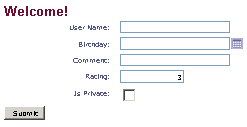

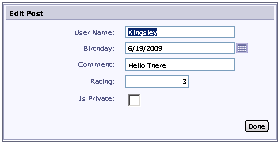 The fields magically get display with some editing components defaulted in based on type of the field in all the three areas we changed.
MetaUI assembles interfaces by applying rules to dynamically (and recursively) select
and configure AWComponents -- the exact same components in AribaWeb Core and Widgets that
we learned about in Part I and Part II.
This results in less code and higher productivity.
The fields magically get display with some editing components defaulted in based on type of the field in all the three areas we changed.
MetaUI assembles interfaces by applying rules to dynamically (and recursively) select
and configure AWComponents -- the exact same components in AribaWeb Core and Widgets that
we learned about in Part I and Part II.
This results in less code and higher productivity.
Notice that we can mix AW elements and Widgets elements with MetaUI.
That is because MetaContext and MetaIncludeComponent are just AW elements that interact with the MetaUI rule engine.
To understand the interaction, we need to understand the MetaUI fundamentals: rules, context, and properties...
Rules
A Rule defines a map of properties that should apply in the event that a set of Selectors
are matched. Given a rule base Meta and a set of asserted values Context a list of matching
rules can be computed (by matching their selectors against the values) and by successively (in
rank / priority order) applying (merging) their property maps, a set of effective properties can
be computed.
Each rule can be stated like this:
If selectors [__,__,...] match the current context values,
then apply the properties [__,__,...].
These rules can come from a variety of sources:
Runtime introspection of Java classes
These rules declare the available properties (fields) and actions, along with their data types.
Example: "What are the fields in the app.Post class?" In rules term:
If selectors [class=app.Post, declare=field]
match the current context values,
then apply the properties
[field:userName]
If selectors [class=app.Post, declare=field]
match the current context values,
then apply the properties
[field:isPrivate]
Annotations on Java classes
Annotations can provide additional information not inferable from the class alone.
Example: "Is the username required?" In rules term:
If selectors [class=app.Post, field=username]
match the current context values,
then apply the properties
[trait:required]
Built-in rules
MetaUI includes a base set of rules to describe, for instance, a mapping from field data type to UI component.
Example: "If it's a Date and we're editing, use the date field." In rules term:
If selectors [field=any, type=Date, editable=true]
match the current context values,
then apply the properties
[component:DateField]
Application provided rules
Applications may provide explicit rules via "object style sheet (oss) files". These are a convenient place to express presentation-oriented rules that really don't belong in (UI agnostic) domain classes.
Example: "The comment field should appear after isPrivate field." In rules term:
If selectors [class=app.Post, field=comment]
match the current context values,
then apply the properties
[after:isPrivate]
Other Sources of Meta Data
Many applications have other external sources of information about the application's domain classes. For instance, an application may have ORM meta data (perhaps expressed in annotations or in XML files) that provide additional information about classes and fields that should be taken into account when creating user interfaces (e.g. "is this field an owned to-many relationship?"). MetaUI provides generic hooks for integrating such sources of metadata (in fact, the metadata sources above integrate via these same hooks).
We'll go into more details for each type of rules, but for now let's take a look at context and properties...
Context and Properties
Context represents a stack of assignments (e.g. object="$post", operation="create", layout="Inspect").
The current values are run against the Meta rule set to compute the effective property map.
The property map holds property key/value pairs that directly affects the UI (eg, component="AWCheckbox", editable="$false")
This is similar to how CSS works. HTML elements can have classes to provide context. For example:
// Example.htm
<div class="box">
<h1>Hey</h1>
</div>
<div class="X">
<div class="box">
<h1>There</h1>
</div>
</div>
Then you have rules that depending on the context and how they are nested, you get different styling properties:
// Foo.css
.box {
border:1px solid red;
width:100px;
float:left;
color:green;
}
/*
if an element with class "box" that is contained
in an element with class "X",
then applies these properties
*/
.X .box {
border:3px solid blue;
background-color:yellow;
}
/*
if a h1 element is contained
in an element with class "box" that is contained
in an element with class "X",
then applies these properties
*/
.X .box h1 {
color:orange;
}

If multiples rules match, properties are merged and overridden.
In this example,the "There" element merged the width and float properties,
but overrode the border and color properties from more specific rules.
In MetaUI, context values are set using MetaContext:
<m:Context object="$newPost" operation="create" layout="Inspect">
<m:IncludeComponent/>
</m:Context>
<m:Context object="$newPost" operation="view" layout="Inspect">
<m:IncludeComponent/>
</m:Context>
Then you have rules that depending on the context and how they are nested, you get different UI properties:
If selectors [operation=create, field=any]
match the current context values,
then apply the properties
[editing:true]
If selectors [operation=view, field=any]
match the current context values,
then apply the properties
[editing:false]

MetaIncludeComponent and various Meta components takes the effective property map to generate the UI.
Here are some interesting context keys:
- module Global nav tab
- layout Define a named layout (e.g. "Inspect", "SearchForm", "TableRow")
- operation "view", "edit", "create", "search"
- class Full class name (org.package.Class), Can be derived from object
- object Object instance (e.g. a User object)
- action An action (e.g. could be fired from a button)
- field current field of class
- type (Java) type of current field
- elementType If type is collection, the type of its elements
- editing Currently editing? Derived from operation
- trait Current traits in effect (like CSS classes)
Here are some interesting property keys:
General
- trait List of traits to apply
- after Name of item (or zone) that this item should follow (for layout order)
- visible Should current item be shown
- component AW Component name to use for display
- bindings Map of bindings to pass to component
- wrapperComponent Name of component to wrap around this component (also, wrapperBindings)
Class
- fieldsByZone Map of List<Fields> for the layout zones (e.g. "zTop", "zLeft", ?)
- zonePath Zone key path for sub map to render
Layout, Module, Field, Action
Field
- editable Should current field be editable
- valid Is current value valid
Layout
- layoutsByZone List of sub-layout names grouped by zone (zTop, zLeft, ?)
Action
- actionResults AWResponseGenerating result: fires action
We can get a better understanding of the runtime using component inspector...
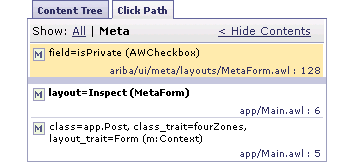 Bring up component inspector by Alt-clicking on the Is Private checkbox, and then click on "Meta" to filter the click path down to just the Meta elements.
You can see that another Meta element MetaForm and multiple MetaContext and MetaIncludeComponent are involved in constructing this UI.
Bring up component inspector by Alt-clicking on the Is Private checkbox, and then click on "Meta" to filter the click path down to just the Meta elements.
You can see that another Meta element MetaForm and multiple MetaContext and MetaIncludeComponent are involved in constructing this UI.
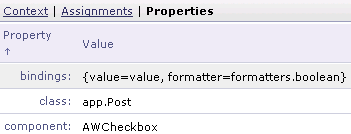 Then click on the "Meta Properties" tab, and then "Properties". It shows the effect properties and their final computed values.
MetaIncludeComponent uses the component property to bring in the right component and uses the bindings property passes to it AW bindings.
Then click on the "Meta Properties" tab, and then "Properties". It shows the effect properties and their final computed values.
MetaIncludeComponent uses the component property to bring in the right component and uses the bindings property passes to it AW bindings.
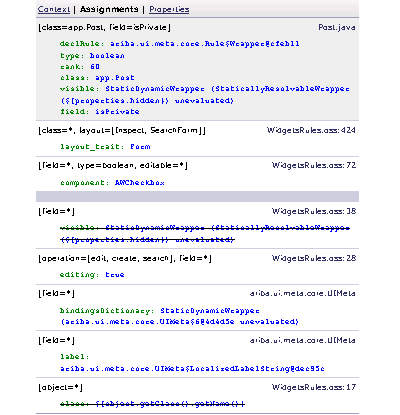 Click on "Assignments" to see the rules that are applicable in the current context. For each rule, we see:
- the selectors and property map
- the source of each rule (OSS, Java introspection, etc)
- the ranking. The first rule listed has the highest priority. Properties in lower priority rules are overridden or merged.
Click on "Assignments" to see the rules that are applicable in the current context. For each rule, we see:
- the selectors and property map
- the source of each rule (OSS, Java introspection, etc)
- the ranking. The first rule listed has the highest priority. Properties in lower priority rules are overridden or merged.
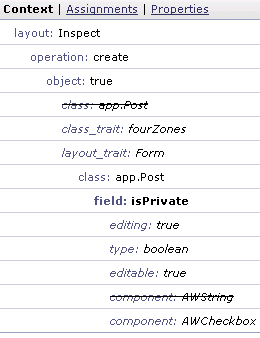 Click on "Context" to see the context stack at the point of the element.
In our example, we used MetaContext to directly assign values to the context.
We see that object, operation, and layout is in the context stack, but where did the others come from?
Some are set explicitly by various Meta components internally using MetaContext.
The context values can either be from the current property map or from other sources.
Click on "Context" to see the context stack at the point of the element.
In our example, we used MetaContext to directly assign values to the context.
We see that object, operation, and layout is in the context stack, but where did the others come from?
Some are set explicitly by various Meta components internally using MetaContext.
The context values can either be from the current property map or from other sources.
Here are some of the interesting context keys that are explicitly set into the context:
- field set by MetaForm, MetaTableColumnRenderer, MetaTableDetailColumnRenderer
- action set by MetaActionList, MetaNavCommandBar
- actionCategory set by MetaActionList, MetaNavCommandBar
- class set by MetaDetailTable, MetaNavCommandBar
- object set by MetaTable, MetaTableColumnRenderer, MetaTableDetailColumnRenderer, MetaDetailTable
- layout set by MetaTable, MetaTableColumnRenderer, MetaDetailTable, MetaSection, MetaTabs, MetaDashboardLayout
- module set by MetaHomePage, MetaNavCommandBar
- displayGroup set by MetaDetailTable
- dataSourceType set by MetaDetailTable
However, some are implicitly set by the MetaUI engine. It's time to talk about chaining...
Chaining
Chaining is when some properties resulting from one rule are fed back as new context assignments, resulting in new matches.
These context assignments are "implied" by the current assignments are applied, (resulting in a revised computation
of the current property map, and possible further chaining).
Referring to the rules listed below, we can see how this particular chaining sequence happens:
Not all properties are chained. The following are some of the interesting properties that are chained:
- class
- type
- elementType
- trait
- editable
- editing
- layout
- component
You should now have a sense of the power of rule based UI.
Most of the rules to generate the UI are already available from the domain object,
or are conventions that are redundant to repeat.
We don't need to worry about updating all the areas every time we add/remove/change a field,
but we lost some of the modifications we made from the previous chapter.
Let's see how we can add some more rules to easily to restore them. We'll start with annotation rules...
Annotation Rules
Let's add back "Name" as the label for the userName field like this:
import ariba.ui.meta.annotations.Property;
@Property.Label("Name")
public String userName;
 The set of annotations in Property creates rules with selectors [class=className, field=fieldName].
So in our example, this rule was created:
The set of annotations in Property creates rules with selectors [class=className, field=fieldName].
So in our example, this rule was created:
If selectors [class=app.Post, field=userName]
match the current context values,
then apply the properties
[label:"Name"]
We can also annotate any property like this with the general Properties annotation:
import ariba.ui.meta.annotations.Properties;
@Properties("label:'Name';")
public String userName;
We can similiarly add trait properties with Trait annotations like this:
import ariba.ui.meta.annotations.Trait;
@Property.Label("Name")
@Trait.Required
public String userName;
@Trait.RichText
public String comment;
We can also annotate any trait property like this with the general Traits annotation:
import ariba.ui.meta.annotations.Traits;
@Traits("required")
public String userName;
The following rules are created:
If selectors [class=app.Post, field=userName]
match the current context values,
then apply the properties
[trait:required]
If selectors [class=app.Post, field=comment]
match the current context values,
then apply the properties
[trait:richtext]
 Now the userName field is required and RichTextArea is for the comment field in all the areas that is using MetaUI!
Now the userName field is required and RichTextArea is for the comment field in all the areas that is using MetaUI!
We've discussed how MetaIncludeComponent switches in the right component with the component property through chaining.
As mentioned, the trait property is chained back to the context, but where are the rest of rules involved?
This takes us to the MetaUI built-in rules...
Built-in Rules
AN important source of built-in rules are specified in WidgetsRules.oss.
In this file, you will find many useful rules for data type, decoration, trait, operation, layout, action, and module in OSS.
In particular, you will find these nested OSS rules:
field {
type=java.lang.String {
@trait=richtext {
after:zBottom;
bindings:{escapeUnsafeHtml:true}
editable {
component:RichTextArea;
bindings:{cols:60; rows:10}
}
operation=(search) { after:zNone }
operation=(list) { editable:false; after:zDetail; }
}
We'll cover the OSS syntax in more details in a different tutorial, but this is one of the rules:
If selectors [field=any, type=String,
trait=richtext, editable=true]
match the current context values,
then apply the properties
[component:RichTexArea]
In combination with the above annotation rule and chaining, the component property is applied.
The component for the rating field also got defaulting to AWTextField similarly,
but let's create an application rule to restore the RatingBar component...
Application Rules
First, we need to add a "Application.oss" file and "rules.oss" file in the app/ directory.
Then in rules.oss, add the following:
class=app.Post field=rating {
component:RatingBar;
}
This results in this rule:
If selectors [class=app.Post, field=rating]
match the current context values,
then apply the properties
[component:RatingBar]
 And with that, we just overrode the default component property.
To see how MetaUI determine how properties from multiple rules are applied,
we need to understand how rules are loaded and ranked...
And with that, we just overrode the default component property.
To see how MetaUI determine how properties from multiple rules are applied,
we need to understand how rules are loaded and ranked...
Rule Loading
On application initialization:
Application code can call Meta APIs to programmatically load rules files or register rules.
Rule Ranking
Visibility
Let's continue by adding some advanced annotation rules.
We want to hide the comment field when we are not editing and isPrivate is true with the Visible annotation:
@Property.Visible("${properties.editing || !object.isPrivate}")
public String comment;
which creates this rule:
If selectors [class=app.Post, field=comment]
match the current context values,
then apply the properties
[visible:${properties.editing || !object.isPrivate}]
 The comment is hidden for Post with isPrivate == false as expected.
Also note that the property value is not just a literal in this case, but rather a dynamic value using expressions.
The expression is evaluating when the property is accessed.
The comment is hidden for Post with isPrivate == false as expected.
Also note that the property value is not just a literal in this case, but rather a dynamic value using expressions.
The expression is evaluating when the property is accessed.
Expressions are wrapped in ${?} and use the AribaExpr language.
The same kind of expression we discussed in Part I AribaWeb Core.
However, when used in property value, the "this" is the Context object - key paths reference assignments in context
The context also has special keys for the following:
- object The current object instance set on the context by the object context key
- value The field value from evaluating the current field on the current object in the context
- properties The current property map
- requestContext The current AWRequestContext
Validation
Next we add a validation on the birthday to ensure that it's not a future date with the Validation annotation:
@Property.Valid("${object.isValidBirthday}")
public Date birthday;
which creates this rule:
If selectors [class=app.Post, field=birthday]
match the current context values,
then apply the properties
[valid:${object.isValidBirthday}]
We need to define the validation method like this:
public Object isValidBirthday () {
if (birthday == null || birthday.before(new java.util.Date())) {
return true;
}
return "Birthday cannot be in the future";
}
 The method return true if birthday is valid. Otherwise, we return an error message.
It automatically shows up if the validation fails.
The method return true if birthday is valid. Otherwise, we return an error message.
It automatically shows up if the validation fails.
Editibility
Let's add a rule to prevent the editing of the userName field if the value is "admin".
So we annotate the field like this:
@Property.Editable("${properties.editing && value!='admin'}")
public String userName;
which creates this rule:
If selectors [class=app.Post, field=userName]
match the current context values,
then apply the properties
[editable:${properties.editing && value!='admin'}]
 Create a post with userName admin, and we see that it is not editable in the edit panel.
Create a post with userName admin, and we see that it is not editable in the edit panel.
Actions
Let's add a method in the Post object and expose it as an action in the UI.
In Post.java, add this:
import ariba.ui.meta.annotations.Action;
@Action(message="isPrivate set to %s")
public boolean toggleIsPrivate () {
isPrivate = !isPrivate;
return isPrivate;
}
and in Main.java:
public void add () {
...
_displayGroup.setSelectedObject(_newPost);
_newPost = new Post();
}
These rules are created by introspection on the Action annotation:
If selectors [class=app.Post, declare=action]
match the current context values,
then apply the properties
[action:toggleIsPrivate]
If selectors [class=app.Post, action=toggleIsPrivate]
match the current context values,
then apply the properties
[trait:[instance,messageResults],
message:"isPrivate set to %s"]


 The toggle button now appears at the bottom of the DataTable.
Clicking on it will toggle the isPrivate boolean on the selected post,
and you see the visibility of the comment being displayed and hidden.
Also, the message specified in the annotations shows up in the page banner.
The chained trait=messageResults property matches this important rule in WidgetsRules.oss:
The toggle button now appears at the bottom of the DataTable.
Clicking on it will toggle the isPrivate boolean on the selected post,
and you see the visibility of the comment being displayed and hidden.
Also, the message specified in the annotations shows up in the page banner.
The chained trait=messageResults property matches this important rule in WidgetsRules.oss:
If selectors [action=any, trait=messageResults]
match the current context values,
then apply the properties
[actionResults:${
/*
- evaluate the action on the object
- format the message with the result vale
- set the message on the page banner
- and return the current page
*/
}
]
The actionResults property value is dynamiclly evaluated by MetaActionList,
and the resulting page is returned.
Let's see how we can specify rules with this property to restore our delete and edit actions on the table.
Refactor the deleteCurrent() in Main.java as follows:
public void deleteCurrent () {
delete(_currentPost);
}
public void delete (Post post) {
_posts.remove(post);
updateDisplayGroup();
}
Then add these OSS rules to rules.oss:
class=app.Post @action=Delete {
trait:instance;
actionResults:${
requestContext.pageComponent().delete(object);
null}
}
class=app.Post @action=Edit {
trait:instance;
actionResults:${
requestContext.pageWithName("EditPost",
[post:object,
clientPanel:true])}
}
These four rules are created:
If selectors [class=app.Post, declare=action]
match the current context values,
then apply the properties
[action=Delete]
If selectors [class=app.Post, action=Delete]
match the current context values,
then apply the properties
[trait:instance,
actionResults:${
requestContext.pageComponent().delete(object);
null}
]
If selectors [class=app.Post, declare=action]
match the current context values,
then apply the properties
[action=Edit]
If selectors [class=app.Post, action=Edit]
match the current context values,
then apply the properties
[trait:instance,
actionResults:${
requestContext.pageWithName("EditPost",
[post:object,
clientPanel:true])}
]
 The edit button should now open up the modal panel with the selected object,
and delete should delete the selected object.
The edit button should now open up the modal panel with the selected object,
and delete should delete the selected object.
Let's also take advantage of this in the list tab.
We can replace the list of AWHyperlink with this:
said:
[<m:Context object="$currentPost" layout="Links">
<m:IncludeComponent/>
</m:Context>]
<br/>
 And now we can get the same benefits with updating actions as upading fields.
New actions are automatically exposed when a Post object is in the context.
And now we can get the same benefits with updating actions as upading fields.
New actions are automatically exposed when a Post object is in the context.
Next, we'll see the other layouts MetaUI can assemble on the fly...
Layouts
Top level application tabs can be declared implicitly
as modules with the NavModuleClass annotation
import ariba.ui.meta.annotations.NavModuleClass;
@NavModuleClass
public class Post {
or declared explicitly in Application.oss:

These Module tabs are generated by MetaNavTabBar.
Modules can specify a custom homePage component.
The default homePage component is MetaHomePage which allows for nested layout declarations,
positioned in a five zone grid (zToc, zTop, zLeft, zRight, and zBottom) via MetaDashboardLayout.
Let's restore the home page for the Post in Application.oss:
module=app.Post {
homePage:Main;
}
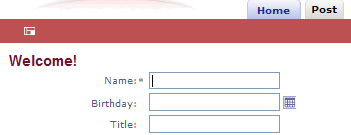
Top level application action categories and actions can be declared in the zNav zone.
Let's declare a "Create" action category with one "Post" action in Application.oss:
@actionCategory=Create {
after:zNav;
@action=Post {
actionResults:${requestContext.pageWithName("Main")};
}
}

Click on the Create Post action and notice that the correct tab is highlighted.
Global navigation action layouts by MetaNavCommandBar.
Let's add some content to the Home module in each of the five zones with this in Application.oss:
@module=Home {
@layout=Hint#Hint {
bindings:{
value:"Welcome!";
}
}
@layout=HelloNorthAmerica#pad8 {
after:zToc;
component:AWString;
bindings:{
value:"North America";
}
}
@layout=HelloSouthAmerica#pad8 {
after:HelloNorthAmerica;
component:AWString;
bindings:{
value:"South America";
}
}
@layout=HelloEurope#pad8 {
after:zLeft;
component:AWString;
bindings:{
value:"Europe";
}
}
@layout=HelloAfrica#pad8 {
after:HelloEurope;
component:AWString;
bindings:{
value:"Africa";
}
}
@layout=HelloAsia#pad8 {
after:zRight;
component:AWString;
bindings:{
value:"Asia";
}
}
@layout=HelloAustralia#pad8 {
after:HelloAsia;
component:AWString;
bindings:{
value:"Australia";
}
}
@layout=HelloAntarctica#pad8 {
after:zBottom;
component:AWString;
bindings:{
value:"Antarctica";
}
}
}
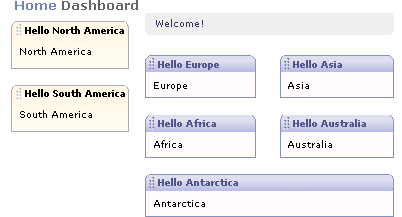
#Hint specifies the layout trait that specifies the after property in the zTop zone.
MetaDashboardLayout is a multi-zone layout that can contain other zoned layouts.
Here's a list of single zone container layout components:
Container layouts can in turn contain other container layouts or object layouts and action layouts.
Here's a list of object layouts:
- MetaForm Displays a single object; specified with #Form; zones:zTop, zLeft, zRight, zBottom
- MetaList Displays a list of objects; single zone.
- MetaTable Displays a list of objects; specified with layout="Layout"; zones:zDetail
- MetaActionList Displays a list of actions; specified with #ActionMenu, #ActionButtons, or #ActionLinks;
specified with #InstanceActionButtons or #StaticActionButtons in the context of layout="Table";
Here's an example in a different context:
Make the root layout a "Stack" with an "OutlineBox" and "Tabs" as children. The Tabs layout, has Forms as children
layout=Inspect#Stack {
@layout=Main#OutlineBox {
@layout=Content#Form {}
@layout=Actions#ActionButtons {}
}
@layout#Tabs {
@layout=Overview#Form { zonePath:Overview }
@layout=Details#Form { zonePath:Details }
@layout=Projects#Form { zonePath:Projects; }
}
}

Fields are "zoned" by setting their predecessor with a dotted path (e.g. "Overview.zRight") that is establish as the "zonePath" for the nested form.
Overview.zLeft => name => accountBalance => accountStatus...;
Overview.zRight => birthDay => fullProfile => fileDesc...;
Details.zTop => rating => description => bio;
...
Let's try some to display some Post objects in the Home module belonging to different continents.
Modify each continent layout in Application.oss like this:
@layout=HelloNorthAmerica#pad8 {
after:zToc;
component:MetaList;
bindings:{
list:${
app.Post.postsForContinent
(app.Continent.NorthAmerica)
}
}
}
Create Continent.java and define the continents:
package app;
public enum Continent {
NorthAmerica, SouthAmerica, Europe,
Asia, Africa, Australia, Antarctica
}
Then add some code to generate the initial posts and the continent field in Post.java:
import ariba.util.core.Fmt;
...
@Trait.Required
public Continent continent;
...
public static List Posts = initialPosts();
private static List initialPosts () {
List posts = new ArrayList();
for (Continent continent :
EnumSet.allOf(Continent.class))
{
addInitialPost(posts, continent);
}
return posts;
}
private static void addInitialPost (
List posts, Continent continent)
{
Post post = new Post();
post.userName = "admin";
post.birthday = new Date();
post.title = Fmt.S("First %s Post", continent);
post.comment = Fmt.S("Hello %s!", continent);
post.continent = continent;
posts.add(post);
}
public static List postsForContinent (
Continent continent)
{
List postsForContinent = new ArrayList();
for (int i = 0; i < Posts.size(); i++) {
Post post = (Post)Posts.get(i);
if (post.continent == continent) {
postsForContinent.add(post);
}
}
return postsForContinent;
}
Referenced the generated list in Main.java:
public List _posts = Post.Posts;
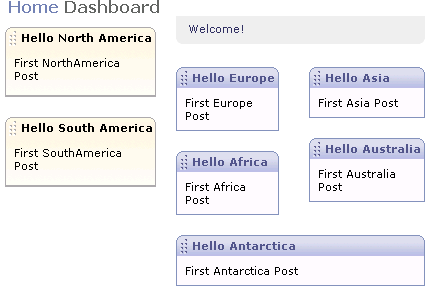
To finish off, let's make a view action on each post listing on the Home module.
Let's reuse EditPost by making the title and operation dynamic like this:
<w:ModalPageWrapper title="$title">
<m:Context object="$post" operation="$operation" layout="Inspect">
And in EditPost.java:
import ariba.ui.aribaweb.util.AWUtil;
...
public String _operation = "edit";
public String title ()
{
return AWUtil.decamelize(_operation, ' ', true) + " Post";
}
Finally, let's tie a hyperlink action to the EditPost in rules.oss:
layout=ListItem class=app.Post {
component:AWHyperlink;
bindings:{
awcontent:${properties.objectTitle};
action:${requestContext.pageWithName("EditPost",
[post:object,
clientPanel:true,
operation:"view"])};
}
wrapperComponent:AWGenericContainer;
wrapperBindings: { tagName:h4; }
}
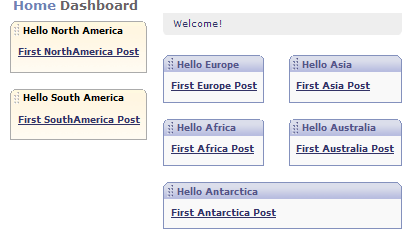
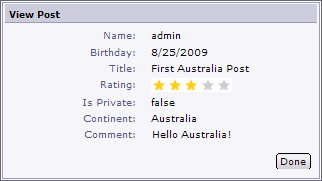
So you've seen how MetaUI works with POJO's to generate various user interfaces derived from annotations and explicit rules.
But what about persistence? This brings us to another layer of MetaUI that deals with persistence...
MetaUI has a persistence abstraction layer, but itself knows nothing about databases.
MetaUI can be used to build UIs on plain old POJOs
(or even atop plain Maps or any other structure for which metadata can be provided). This means that
MetaUI is suitable for non-database applications, applications that use non-relational sources of data,
or applications for which you have your own database persistence solution.
The bundled support in the AribaWeb stack for building database applications is MetaUI-JPA.
This is a small layer -- quite distinct from MetaUI itself -- that binds MetaUI to the Java-standard
JPA persistence APIs (and, by default, the Hibernate ORM layer).
We will cover MetaUI-JPA and the persistence layer of MetaUI in Part IV.
You can find the source code for the final version of this example in examples/GuestBook
Other Areas to Explore
Next up: Part IV: MetaUI-JPA